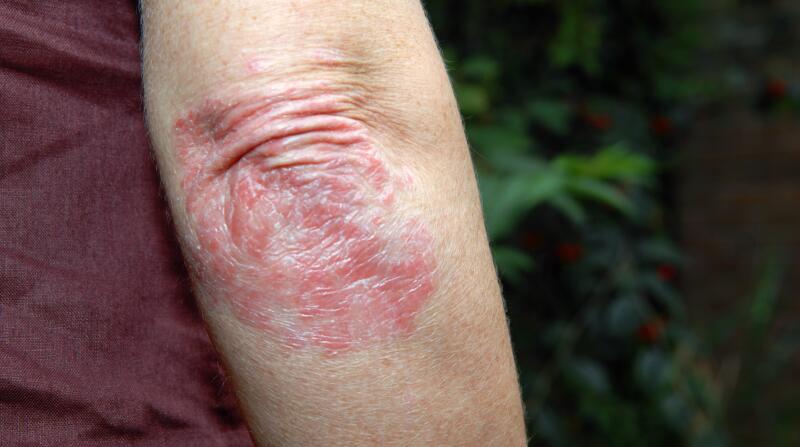10 Things to Know About Psoriatic Arthritis

Medically Reviewed By William C. Lloyd III, MD, FACS
Written By Cindy Kuzma on September 14, 2022
-
 When Your Immune System Attacks Your JointsWhen you have psoriasis, your body's immune system revs up to battle the skin disease. But sometimes the cells that fight psoriasis turn on your joints instead. The resulting condition, called psoriatic arthritis, causes joint pain and redness, swelling, and trouble moving. Prompt treatment can prevent lasting joint damage.
When Your Immune System Attacks Your JointsWhen you have psoriasis, your body's immune system revs up to battle the skin disease. But sometimes the cells that fight psoriasis turn on your joints instead. The resulting condition, called psoriatic arthritis, causes joint pain and redness, swelling, and trouble moving. Prompt treatment can prevent lasting joint damage. -
 1. Doctors are still investigating its mysteries.It's still not clear why some people develop psoriatic arthritis and others don't. About 40 percent of people with psoriatic arthritis have a family history, which points to a genetic risk. Outside factors—including infections, injuries, and smoking—may also play a role. About 85 percent of people who develop psoriatic arthritis have skin psoriasis first.
1. Doctors are still investigating its mysteries.It's still not clear why some people develop psoriatic arthritis and others don't. About 40 percent of people with psoriatic arthritis have a family history, which points to a genetic risk. Outside factors—including infections, injuries, and smoking—may also play a role. About 85 percent of people who develop psoriatic arthritis have skin psoriasis first. -
-
 2. Signs may develop slowly or quickly.As with most types of arthritis, joint pain is the most common symptom of psoriatic arthritis. Others include fatigue, low back pain, and changes in your nails. Your fingers and toes may feel hot or swell up. For some people, symptoms start slowly and worsen with time. Others feel sudden, severe pain.
2. Signs may develop slowly or quickly.As with most types of arthritis, joint pain is the most common symptom of psoriatic arthritis. Others include fatigue, low back pain, and changes in your nails. Your fingers and toes may feel hot or swell up. For some people, symptoms start slowly and worsen with time. Others feel sudden, severe pain. -
 3. Not everyone with psoriasis gets arthritis.Doctors estimate that less than half of people with psoriasis will develop associated joint pain. Symptoms typically appear between ages 30 and 50 and an average of 10 years after a psoriasis diagnosis. Men and women get the disease about equally, as do those with mild or severe skin disease.
3. Not everyone with psoriasis gets arthritis.Doctors estimate that less than half of people with psoriasis will develop associated joint pain. Symptoms typically appear between ages 30 and 50 and an average of 10 years after a psoriasis diagnosis. Men and women get the disease about equally, as do those with mild or severe skin disease. -
 4. There are five types of psoriatic arthritis.Symmetric arthritis affects the same joints on both sides of the body, while asymmetric arthritis doesn't strike equally. Distal interphalangeal predominant arthritis causes pain in the ends of fingers and toes. Spondylitis affects the spinal column. Finally, arthritis mutilans is a rare but severe and destructive form.
4. There are five types of psoriatic arthritis.Symmetric arthritis affects the same joints on both sides of the body, while asymmetric arthritis doesn't strike equally. Distal interphalangeal predominant arthritis causes pain in the ends of fingers and toes. Spondylitis affects the spinal column. Finally, arthritis mutilans is a rare but severe and destructive form. -
 5. Many people remain undiagnosed.A recent National Psoriasis Foundation survey found about 2 million Americans have been diagnosed with psoriatic arthritis. However, many weren't diagnosed until an average of two years after their first symptoms. And about one in five people with psoriasis without a diagnosis of psoriatic arthritis reported symptoms such as swelling and pain in their joints.
5. Many people remain undiagnosed.A recent National Psoriasis Foundation survey found about 2 million Americans have been diagnosed with psoriatic arthritis. However, many weren't diagnosed until an average of two years after their first symptoms. And about one in five people with psoriasis without a diagnosis of psoriatic arthritis reported symptoms such as swelling and pain in their joints. -
-
 6. There's no single test to spot psoriatic arthritis.Talk with your doctor if you have symptoms of psoriatic arthritis. He or she may do blood tests, take X-rays or scans, examine your joints, and ask you about your symptoms. This helps rule out other types of arthritis, including rheumatoid arthritis and gout.
6. There's no single test to spot psoriatic arthritis.Talk with your doctor if you have symptoms of psoriatic arthritis. He or she may do blood tests, take X-rays or scans, examine your joints, and ask you about your symptoms. This helps rule out other types of arthritis, including rheumatoid arthritis and gout. -
 7. Specialists help you get the best treatment.Your primary care doctor or dermatologist may be the first person you see when you have a problem. If you have symptoms of psoriatic arthritis, he or she may recommend you see a rheumatologist as well. This doctor has special training in identifying and treating all types of arthritis.
7. Specialists help you get the best treatment.Your primary care doctor or dermatologist may be the first person you see when you have a problem. If you have symptoms of psoriatic arthritis, he or she may recommend you see a rheumatologist as well. This doctor has special training in identifying and treating all types of arthritis. -
 8. Treatment relieves symptoms, slows joint damage.There is no cure for psoriatic arthritis, but treatments can help you feel better and make life easier. Options range from over-the-counter medications to prescription drugs, injections, and surgery. Some therapies also protect your joints from damage that occurs as the disease progresses—so it's important to get treatment early.
8. Treatment relieves symptoms, slows joint damage.There is no cure for psoriatic arthritis, but treatments can help you feel better and make life easier. Options range from over-the-counter medications to prescription drugs, injections, and surgery. Some therapies also protect your joints from damage that occurs as the disease progresses—so it's important to get treatment early. -
 9. Medications reduce pain and inflammation.Your doctor may first recommend anti-inflammatory medications, such as ibuprofen and naproxen. If your arthritis doesn't respond, drugs called disease-modifying antirheumatic drugs (DMARDs) are next. Some examples of these include sulfasalazine (Azulfidine), methotrexate (Rheumatrex), etanercept (Enbrel), infliximab (Remicade), adalimumab (Humira), and secukinumab (Cosentyx).
9. Medications reduce pain and inflammation.Your doctor may first recommend anti-inflammatory medications, such as ibuprofen and naproxen. If your arthritis doesn't respond, drugs called disease-modifying antirheumatic drugs (DMARDs) are next. Some examples of these include sulfasalazine (Azulfidine), methotrexate (Rheumatrex), etanercept (Enbrel), infliximab (Remicade), adalimumab (Humira), and secukinumab (Cosentyx). -
 10. Lifestyle changes also help.Losing weight relieves pressure on your joints. Eating a healthy diet rich in fruits, vegetables, and whole grains ensures your body gets enough nutrients. Hot baths or cold packs can relieve pain and swelling. And doing arthritis-friendly exercises loosens joints, strengthens muscles, and improves your overall health.
10. Lifestyle changes also help.Losing weight relieves pressure on your joints. Eating a healthy diet rich in fruits, vegetables, and whole grains ensures your body gets enough nutrients. Hot baths or cold packs can relieve pain and swelling. And doing arthritis-friendly exercises loosens joints, strengthens muscles, and improves your overall health.
Your Opinion Matters!
In order to improve our content, we want to hear from you. Please take this short anonymous survey to let us know how we’re doing.
Take the survey!
10 Things to Know About Psoriatic Arthritis




















